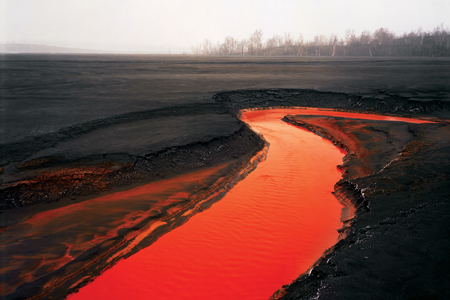|
Reviews of Recent Independent, Foreign, & Documentary Films in Theaters and DVD/Home Video
Directed by: Jennifer Baichwal. Produced by: Nick de Pencier, Daniel Iron & Jennifer Baichwal. Director of Photography: Peter Mettler. Edited by: Roland Schlimme. Music by: Dan Driscoll. Released by: Zeitgeist Films. Language: English and Chinese with English subtitles. Country of Origin: Canada. 90 min. Not Rated. Director Jennifer Baichwal and cinematographer Peter Mettler follow in the tradition of the 1930’s social and poetic documentary films by Pare Lorentz and Willard Van Dyke. Just as those visual essays traced crises in the environment and rural and city life during the Depression, this team looks at how the globalization boom similarly impacts the world, particularly in China, through the photographs of Edward Burtynsky. Though its focus has been seen in other fiction and documentary films, Burtynsky and the filmmakers bring both an aesthetic and mournful eye. The film opens with a slow, lengthy pan in a Chinese assembly plant – row after endless row of workers at different repetitive tasks, bins of finished goods, and boxes ready to ship. The bell signaling the end of the workday leads to another visual jolt as workers pour out of this building, just one of many in a giant complex called "Factory of the World," which stretches into the horizon. From a high scaffold outside, Burtynsky sets up his photograph. The filmmakers use his beautifully composed large-scale shots as a take-off point. Smooth editing shifts from the actual location to his photograph, then to it mounted on a wall, gallery visitors looking at it, and finally, Burtynsky using it in a slide lecture like another environmentalist – An Inconvenient Truth’s Al Gore. Growing up near a big auto plant, like Michael Moore, Burtynsky is fascinated by industrialization, and his earlier photographs found stark beauty in North American lands long mined for nickel, copper, and iron ore. (His team gets permission to photograph a huge coal slag site in China with the argument he will make it look beautiful.) In an unusually honest appraisal, he quietly explains his epiphany at an old coal mining town in Pennsylvania; he was complicit in the extraction industries – just getting there and taking photographs uses resources like silver and oil. In China, families sort through mountains of used metal and electronics parts, very similar to life seen at the Guatemala City Garbage Dump in the Oscar-nominated documentary Recycled Life. Burtynsky calls this “e-waste,” claiming China recycles half of the world’s computers, with their dangerously toxic waste polluting whole villages. The finished factory goods are followed through fleets of trucks to the staggeringly busy shipyard in Qiligang, where ships can’t be built fast enough to accommodate the towers of containers waiting for transport. Incorporating black-and-white footage and color photographs from Burtynsky’s earlier travels, the final destination of such ships is seen through the boys and young men who toil at the notoriously polluted ship breaking beaches of India and Bangladesh. Filled with discarded tankers, these yards have also been photographed extensively by Sebastião Salgado and investigated by a Pulitzer Prize-winning Baltimore Sun team and by writer William Langewiesche. Because of the mammoth scale involved, the glory of bringing hydroelectric power to the masses isn’t quite as optimistic as Woody Guthrie sang when celebrating the damming of the Columbia River. As the largest engineering project in the world, China’s Three Gorges Dam displaced about a million people in three cities, who were paid to dismantle their homes. To a lovely electronica score, Burtynsky and the filmmakers track the cities gradually disappearing into rubble.
Burtynsky comments that Mao Tse-tung presided over a China that was 90% rural and is now heading towards 30% agrarian and 70% urban. While
urbanization is an old story since the West’s own gritty industrial revolution (a brutal past the filmmakers ignore even as Burtynsky recognizes
that China is just “late to the party”), we finally meet someone who benefits most from the changes – a real estate developer. “Shanghai is for the
young” explains this wealthy woman as the camera moves from nightclub dancers to an elderly holdout who wouldn’t sell her property. As Burtynsky
denies any political content to his work – “It’s not a simple right or wrong. We need a whole new way of thinking” – a hammer and sickle are seen
fading away in a flashing neon sign.
Nora Lee Mandel
|

